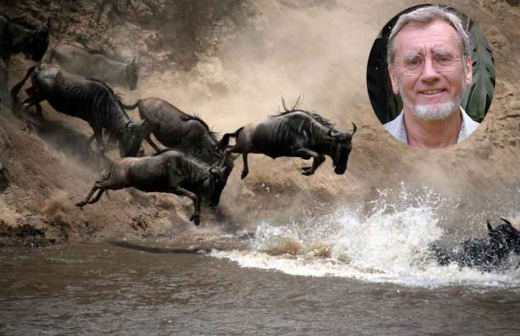
Kenyans have been immersed in an endless election farce, the death of the man who exposed the wildebeest migration as a global phenomenon went unnoticed. Alan Root died on August 26 aged 80. Brain cancer, it was.
The celebrated wildlife documentary filmmaker was in the national limelight in 2012 when his Hughes 500 chopper landed in a shamba in misty Kahara village in Mathira, Nyeri County. Root was piloting his sons, Myles and Rory to Nairobi’s Banda School from their home in Lewa Downs Conservancy in Laikipia, when foggy weather caused low clouds and hence poor visibility.
The story of his chopper landing was aired in all major local television stations as Kenyans were still mourning the deaths of six countrymen, among them Internal Security minister George Saitoti and his assistant Orwa Ojode. The story also stirred debate on ‘how the other half lives’ in Kenya. While his passing went unnoticed, the international media paid glowing tributes. The New York Times noted that Root was “an innovative wildlife filmmaker with a daredevil streak and the scarred body to prove it.”
Root, whose family came to Kenya in 1947, had been through worse incidents than the emergency landing. He survived two previous chopper crashes, a bout of river blindness, an underwater hippo attack on his leg, a leopard and gorilla bite, and even lost a forefinger to puff adder fangs at the Meru National Park in 1969. The Guardian wrote that Root “was one of the first people to bring Africa’s wildlife to our screens” as “a pioneering wildlife filmmaker whose life often seemed to be something out of an Indiana Jones movie,” while The Independent wrote that Root was devoid of formulaic making of documentaries and lived close to his animals, a “repertoire of baboon alarm calls, elephant farts and wildebeest contact calls.”
The writer, George Plimpton, was a frequent visitor to his Naivasha home (before he left it to his wife Joan Root after their divorce) and he recalled one trip in 1999 when “what I thought was a water bed on the far side of the living room got up, walked out the door, across the grass, and into the lake — a pet hippo named Sally.” But it was in filming the wildebeest migration, now considered among the Seven Wonders of the World that Root cemented his name. His documentaries, still screened on National Geographic, are one-hour, ecologically-themed affairs devoid of human beings as nature takes centre stage.
Indeed, if you have marvelled at the spectacle of 1.5 million wildebeests migrating from the Maasai Mara Game Reserve in Kenya, through crocodile-infested Mara and Grumeti rivers to Serengeti National Park in Tanzania, then it was Root who paved the way when he spent two-and-a-half years from 1972 filming what became The Year of the Wildebeest, which was screened by America’s CBS television in 1976.
It was one of more than a dozen such documentaries on the relentless sequence of life and death using ingenious methods like concealing cameras in tortoise shells to get a snake’s eye view close-up of thundering hooves as famished lions, cheetahs, hyenas, and leopards clawed after their new, exhausted meals.
Another of his novelties was use of time lapse photography, in which flowers bloom right before the viewer’s eyes, while birds build their nests twig by twig in 30-second frames on screen; styles which have been widely imitated.
Then there is the scintillating footage, unfussy or no use of soundtracks interspersed with perceptive, sparse, terse, sarcastic narration.
Sample some from The Year of the Wildebeest: “The wildebeest haven’t changed in two million years. They haven’t needed to for, though they may choose some bizarre ways to die, they have found a fantastically successful way to live.”
And how about this: “The white-bearded gnu — an animal apparently designed by a committee and assembled from spare parts.”
The Year of the Wildebeest is considered Root’s most definitive cinematic effort despite winning the 1959 Oscar Award for Best Documentary Feature for Serengeti Shall Not Die at only 21.
The recipient of over 60 global recognitions, including two Emmys, a Peabody, and several “Lifetime Achievement Awards,” was awarded the Order of the British Empire (OBE) during Queen Elizabeth’s birthday honours in 2008 for “services to wildlife filmmaking.”
It was quite a full life for someone who left school at 16 to have a love affair with the camera in 1956, seven years before Kenya’s independence.
 The Standard Group Plc is a multi-media organization with investments in media
platforms spanning newspaper print
operations, television, radio broadcasting, digital and online services. The
Standard Group is recognized as a
leading multi-media house in Kenya with a key influence in matters of national and
international interest.
The Standard Group Plc is a multi-media organization with investments in media
platforms spanning newspaper print
operations, television, radio broadcasting, digital and online services. The
Standard Group is recognized as a
leading multi-media house in Kenya with a key influence in matters of national and
international interest.



